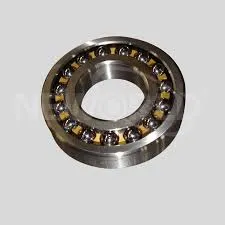
Nov . 19, 2024 02:37 Back to list
spherical roller bearing mounting
Mounting Spherical Roller Bearings A Comprehensive Guide
Spherical roller bearings are unique types of rolling bearings designed to accommodate misalignment and heavy loads, making them ideal for various industrial applications. The mounting process is critical to ensuring their performance and longevity. This article discusses the fundamental steps and considerations involved in the mounting of spherical roller bearings.
Understanding Spherical Roller Bearings
Spherical roller bearings consist of an inner ring, an outer ring, rolling elements (usually spherical), and a cage. The self-aligning feature of these bearings allows for angular misalignment between the shaft and housing, which is particularly beneficial in applications subjected to varying loads and vibrations.
Importance of Proper Mounting
Effective mounting of spherical roller bearings is essential for several reasons
1. Performance Optimization Properly mounted bearings reduce friction and wear, ensuring smooth operation. 2. Longevity Correct installation minimizes the risk of premature failure. 3. Load Distribution Proper alignment helps in evenly distributing loads, reducing stress on the bearing surfaces.
Tools and Equipment Required
Before beginning the mounting process, gather the necessary tools and materials
- Bearing press or hydraulic press - Pullers (if required for disassembly) - Torque wrenches - Measuring tools (like micrometers) - Lubrication tools - Cleaning solvents
Using the right tools prevents damage to the bearings and ensures efficient installation
.Step-by-Step Mounting Procedure
spherical roller bearing mounting

1. Preparation of Components Begin by cleaning the bearing, shaft, and housing thoroughly. Remove any contaminants, dust, or old lubricants that can impact performance.
2. Inspection Examine the bearing for any signs of damage or wear. Ensure that the shaft and housing are within specified tolerances to prevent improper fit.
3. Heating the Inner Ring For interference fits, heat the inner ring before mounting. This can be done by placing the bearing in an oven or using induction heating. The optimal temperature is typically 80-100°C (176-212°F). Ensure not to exceed 120°C (248°F) to avoid damage.
4. Mounting the Inner Ring Slide the heated bearing onto the shaft quickly and evenly. Use a bearing press to apply force smoothly to prevent distortion.
5. Mounting the Outer Ring If the outer ring also requires an interference fit, the process is similar. Heating the outer ring and then pressing it into the housing ensures a tight fit.
6. Alignment Ensure that the bearing is properly aligned before the housing is secured. Misalignment can lead to increased vibrations, heat generation, and premature failure.
7. Lubrication After mounting, apply the appropriate lubricant to the bearing. The choice of lubricant will depend on the application, operating temperature, and environmental conditions. Follow the manufacturer’s guidelines for the type and quantity of lubricant.
8. Final Checks Once installed, check the bearing’s rotation. It should spin freely without excessive resistance or noise. Verify that the bearing is seated correctly and that there are no visible gaps or misalignments.
Common Mistakes to Avoid
- Improper Heating Overheating the bearing can lead to changes in material properties. Always monitor the temperature carefully. - Neglecting Cleanliness Dust and contaminants can lead to severe damage. Always ensure that your work area and components are clean. - Forgetting Lubrication Failing to lubricate properly can result in rapid wear and failure.
Conclusion
The mounting of spherical roller bearings is a critical operation that can significantly affect the performance and longevity of machinery. By following the correct procedures and taking time to prepare and inspect components, you can ensure that these bearings perform optimally in their applications. Remember that attention to detail during the mounting process will contribute to the reliability and efficiency of the entire system.
Latest news
-
Durable Greenhouse Pillow Block Bearings for Reliable Ventilation
NewsAug.31,2025
-
Spherical Roller Bearings Applications: Heavy Duty, Self-Aligning
NewsAug.30,2025
-
Premium Deep Groove Ball Bearings | High Speed & Reliability
NewsAug.29,2025
-
Durable Scaffolding Clamps - Secure & Reliable Tube Connectors
NewsAug.28,2025
-
Common Failures in Thrust Ball Bearings and Solutions
NewsAug.22,2025
-
How Tapered Roller Bearings Can Take Shock Loads
NewsAug.22,2025
